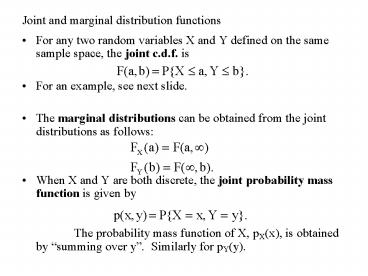Joint and marginal distribution functions - PowerPoint PPT Presentation
1 / 16
Title:
Joint and marginal distribution functions
Description:
For any two random variables X and Y defined on the same sample space, the joint ... In the jointly continuous case, X and Y are independent if and only if ... – PowerPoint PPT presentation
Number of Views:170
Avg rating:3.0/5.0
Title: Joint and marginal distribution functions
1
Joint and marginal distribution functions
- For any two random variables X and Y defined on
the same sample space, the joint c.d.f. is - For an example, see next slide.
- The marginal distributions can be obtained from
the joint distributions as follows - When X and Y are both discrete, the joint
probability mass function is given by
The probability
mass function of X, pX(x), is obtained by
summing over y. Similarly for pY(y).
2
C.D.F. for a Bivariate Normal (density shown
later)
3
Example for joint probability mass function
- Consider the following table
- Using the table, we have
Y0 Y3 Y4
X5 1/7 1/7
1/7 3/7
pX
X8 3/7 0
1/7 4/7
4/7 1/7 2/7
pY
4
Expected Values for Jointly Distributed Random
Variables
- Let X and Y be discrete random variables with
joint probability mass function p(x, y). Let the
sets of values of X and Y be A and B, resp. We
define E(X) and E(Y) as - Example. For the random variables X and Y from
the previous slide,
5
Law of the Unconscious Statistician Revisited
- Theorem. Let p(x, y) be the joint probability
mass function of discrete random variables X and
Y. Let A and B be the set of possible values of
X and Y, resp. If h is a function of two
variables from R2 to R, then h(X, Y) is a
discrete random variable with expected value
given by
provided that the sum is absolutely convergent. - Corollary. For discrete random variables X and
Y, - Problem. Verify the corollary for X and Y from
two slides previous.
6
Joint and marginal distribution functions for
continuous r.v.s
- Random variables X and Y are jointly continuous
if there exists a nonnegative function f(x, y)
such that for every
well-behaved subset C of lR2. The function f(x,
y) is called the joint probability density
function of X and Y. - It follows that
- Also,
7
Density for a Bivariate Normal (see page 449 for
formula)
8
Example of joint density for continuous r.v.s
- Let the joint density of X and Y be
- Prove that (1)
PXgt1,Ylt1 e1(1 e2) (2)
PXltY 1/3 (3) FX(a) 1
ea, a gt 0, and 0 otherwise.
9
Expected Values for Jointly Distributed
Continuous R.V.s
- Let X and Y be continuous random variables with
joint probability density function f(x, y). We
define E(X) and E(Y) as - Example. For the random variables X and Y from
the previous slide, That
is, X and Y are exponential random variables.
It follows that
10
Law of the Unconscious Statistician Again
- Theorem. Let f(x, y) be the joint density
function of random variables X and Y. If h is a
function of two variables from lR2 to lR, then
h(X, Y) is a random variable with expected value
given by
provided the integral is absolutely convergent. - Corollary. For random variables X and Y as in
the above theorem, - Example. For X and Y defined two slides previous,
11
Random Selection of a Point from a Planar Region
- Let S be a subset of the plane with area A(S). A
point is said to be randomly selected from S if
for any subset R of S with area A(R), the
probability that R contains the point is
A(R)/A(S). - Problem. Two people arrive at a restaurant at
random times from 1130am to 1200 noon. What is
the probability that their arrival times differ
by ten minutes or less? Solution. Let X and Y
be the minutes past 1130 am that the two people
arrive. Let
The desired probability is
12
Independent random variables
- Random variables X and Y are independent if for
any two sets of real numbers A and B,
That is,
events EA X? A, EBY? B are independent. - In terms of F, X and Y are independent if and
only if - When X and Y are discrete, they are independent
if and only if - In the jointly continuous case, X and Y are
independent if and only if
13
Example for independent jointly distributed r.v.s
- A man and a woman decide to meet at a certain
location. If each person independently arrives
at a time uniformly distributed between 12 noon
and 1 pm, find the probability that the first to
arrive has to wait longer than 10 minutes.
Solution. Let X and Y denote,
resp., the time that the man and woman arrive. X
and Y are independent.
14
Sums of independent random variables
- Suppose that X and Y are independent continuous
random variables having probability density
functions fX and fY. Then - We obtain the density of the sum by
differentiating -
The right-hand-side of the latter
equation defines the convolution of fX and
fY.
15
Example for sum of two independent random
variables
- Suppose X and Y are independent random variables,
both uniformly distributed on (0,1). The density
of XY is computed as follows - Because of the shape of its density function, XY
is said to have a triangular distribution.
16
Functions of Independent Random Variables
- Theorem. Let X and Y be independent random
variables and let g and h be real valued
functions of a single real variable. Then
(i) g(X) and h(Y) are also independent
random variables - Example. If X and Y are independent, then































